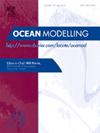The influence of tidal currents and sea ice on wave dynamics in Cook Inlet, Alaska
IF 2.9
3区 地球科学
Q2 METEOROLOGY & ATMOSPHERIC SCIENCES
引用次数: 0
Abstract
Cook Inlet, Alaska is a unique tidal estuary with extreme tidal regimes and the presence of seasonal ice coverage. In this study, the wave dynamics of Cook Inlet are explored through analysis of in-situ wave observations and spectral wave model simulations. The analysis first assesses the wave climate from an existing dataset — showing low-energy wave conditions as a mean state for the upper and lower inlets. Following, wave observations within the inlet are analyzed to reveal modulation by tidal constituents. Finally, a region-specific, ocean circulation coupled, spectral wave model is run over a storm event with current and ice forcings present. This simulation reveals that under extreme wind conditions, large waves can exceed 2 m and 6 m in the upper and lower inlet sections. Simulations results demonstrate that increases in significant wave height up to 1 m are observed due to the effects of wave–current interaction on opposing current gradients. This analysis provides insight into how the tidal phase can amplify or diminish wave energy over large extents of the inlet and the role sea ice plays in limiting regional wave energy. These outcomes demonstrate the combined influence of environmental variables current, water levels, and ice influencing wave dynamics and stress the importance of their implementation in wave modeling frameworks where applicable.
阿拉斯加库克湾潮汐流和海冰对波浪动力学的影响
阿拉斯加的库克湾是一个独特的潮汐口,潮汐状态极端,季节性冰层覆盖。本研究通过现场波浪观测分析和谱波模型模拟,探讨Cook Inlet的波浪动力学。该分析首先评估了现有数据集的波浪气候,将低能波条件显示为上下入口的平均状态。接下来,分析了入口内的波浪观测,以揭示潮汐成分的调制作用。最后,对存在海流和冰强迫的风暴事件运行一个特定区域的、海洋环流耦合的谱波模式。模拟结果表明,在极端风条件下,进风口上下段的大浪可以超过2 m和6 m。模拟结果表明,由于波流相互作用对反向电流梯度的影响,有效波高增加了1 m。这一分析提供了对潮汐相位如何在入口的大范围内放大或减少波浪能量以及海冰在限制区域波浪能量方面所起作用的深入了解。这些结果表明了环境变量电流、水位和冰对波浪动力学的综合影响,并强调了在适用的波浪建模框架中实施它们的重要性。
本文章由计算机程序翻译,如有差异,请以英文原文为准。
求助全文
约1分钟内获得全文
求助全文
来源期刊

Ocean Modelling
地学-海洋学
CiteScore
5.50
自引率
9.40%
发文量
86
审稿时长
19.6 weeks
期刊介绍:
The main objective of Ocean Modelling is to provide rapid communication between those interested in ocean modelling, whether through direct observation, or through analytical, numerical or laboratory models, and including interactions between physical and biogeochemical or biological phenomena. Because of the intimate links between ocean and atmosphere, involvement of scientists interested in influences of either medium on the other is welcome. The journal has a wide scope and includes ocean-atmosphere interaction in various forms as well as pure ocean results. In addition to primary peer-reviewed papers, the journal provides review papers, preliminary communications, and discussions.
 求助内容:
求助内容: 应助结果提醒方式:
应助结果提醒方式:


